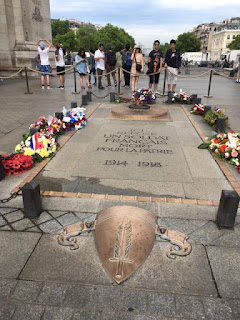Paris, France
Today we took the Metro to the west side of the city for another sight that we just had to see on our first trip to Paris: the Arc de Triomphe. More... Another very recognizable symbol of Paris, this monument honors the victories of Napoleon Bonaparte, as well as all soldiers who fought and died for France during the French Revolutionary Wars and the Napoleonic Wars. The Tomb of the Unknown Soldier from World War I lies directly underneath the main arch, although it now represents the dead who were never identified from both world wars.
The arch has been the site of many famous victory marches, parades and ceremonies:
- Napoleon’s posthumous homecoming in 1840, before his remains were permanently entombed in the Invalides
- the Germans in 1871 (Franco-Prussian War)
- the French in 1919 (World War I)
- the Germans again in 1940 (World War II)
- the French and the Allies in 1944 (the Liberation of Paris, World War II).
Ever since the interment of the Unknown Soldier in 1919, however, these parades and marches have avoided going directly through the main arch, out of respect for the tomb and what it represents. Instead, they usually march up to the arch and then around its sides. Even Hitler honored this custom in 1940.
You can also go to the top of the arch (for an extra fee, of course). It supposedly has a great view of the “historical axis.” This is the perfect alignment of the Arc de Triomphe, the Champs-Elysées, the Obelisk on Place de la Concorde, the Louvre, and more recently, the Grand Arche de la Défense in the far distance. We already had a birds’-eye view of Paris yesterday from the Eiffel Tower, though, so we passed.
Traffic on the giant 8-lane circle around the arch is as crazy as it looks on TV. Supposedly, it’s the only place in Paris where traffic accidents are not judged; insurance companies routinely split the costs 50-50, no matter what the circumstances. (If you decide to rent a car in Paris, you are offered a special insurance package to cover any accidents on the Arc de Triomphe roundabout.) Cars entering the circle are supposed to have the right-of-way; those inside the circle are supposed to yield. Traffic cops are stationed at each entrance to try to control the madness – but it still looks pretty chaotic to the uninitiated. Thank God there are underpasses that pedestrians can use so they don’t have to risk their lives getting to the arch.
Then we took a long walk down the Champs-Elysées (French for “Elysian Fields,” which was the paradise for dead heroes in ancient Greek mythology). It’s one of the most famous streets in the world for upscale retail shopping. Of course, all of the famous French luxury boutiques, such as Cartier, Louis Vuitton, Lacoste, and Guerlain, are here. (Lots of bling in the windows, but nothing we could afford.) But we also saw lots of global chain stores like Abercrombie & Fitch, Adidas, Benetton, the Disney Store, The Gap, Nike, Sephora, and Zara. We almost thought we were back home again!
Our next stop of the day was the Louvre, which used to be a fortress and then later a residence for the French kings. In 1793, after the French Revolution, it opened to the public as a museum and has been one ever since, making it one of the oldest museums in the world. It’s also one of the most visited museums in the world, as well as the largest one. (I can vouch for that, since Gary and I got lost in it several times.)
We were really only interested in seeing a few pieces of the Louvre’s collection, mostly from the Renaissance era, which included the Mona Lisa, of course.
Now known as the most famous painting in the world, the Mona Lisa was painted by the Italian Renaissance artist Leonardo da Vinci from approximately 1503 through 1506 to celebrate the birth of a son to the patron who commissioned it, according to most experts. Leonardo, however, never finished the portrait to his satisfaction (a frequent problem with him), so it was never delivered to the client. He brought it with him to France when he was invited to live and work there by King Francis I in 1516. King Francis acquired it after Leonardo’s death three years later, and it has remained the property of France ever since (except for a brief spell in Italy. It was stolen in 1911 by an Italian patriot who believed that the painting rightly belonged in an Italian museum).
For me, seeing the Mona Lisa painting in person was strangely anticlimactic, one of the few times that’s happened to me while traveling. It’s surprisingly small (30” x 21”). That was considered a large portrait for the time, but I had always imagined it as much more sizable than it actually is. Probably all of the hype I had heard about it made it seem as if it should be “larger than life” in actual size as well as reputation.
Also, because of the past theft and several more recent acts of vandalism, the painting is walled off behind a bullet-proof sheet of glass and a railing. This makes it impossible to get close enough to it to examine the painting’s detail and the model’s supposedly enigmatic smile.
Dinner tonight was at a place back in our neighborhood called Le Bougnat on Rue de Saintonge, which seemed to be popular with the locals. I don’t blame them – great home cooking!








No comments:
Post a Comment